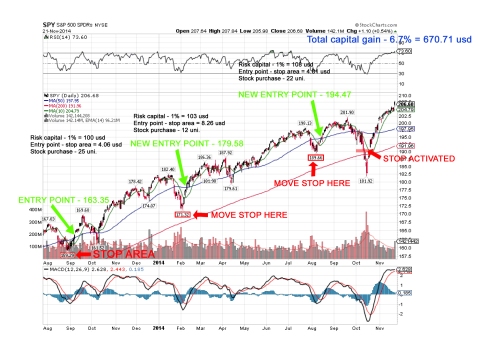4.THE STRATEGY
by theknownothinginvestor
I had gather 10 000 USD in two year, which for Portugal standards is a considerable amount, especially if you have a young family to support and you just saw your pay-check cutted to less than 1500 USD per month.
As I said before I would trade stock’s CFD because of the leverage that I could achieve, which meant that I would have about 100 000 of total funds to invest. Pretty nice, hum?
I also establish that the most I could loose from my total capital was 1000 USD or 10% if you prefer. This rule was my first and I tried to be the strongest rule. If I would lost that amount of money I would stop for somes months for rethink my strategie. But for sure that would not happened.
The trading style that I was more comfortable to practise was trend-following, because it was simple enough for me to understand it and It was quite simple to identify trends. I even got to do some programming based on the moving averages to give me entrance and exit points. My backtesting was quite profitable. I was getting really good…
I also defined that I would buy 10 equities shares for some diversification and mitigation of risk. I would buy 7 longs and sell 3 shorts, based on the 130-30 portfolio strategie because at the time I had read a paper that this was the way to have better returns with smaller risks.
Picking stocks
I started looking for blue chips that were near highs, because if they are near all time highs there is a great possibility that they will go higher. In opposition, to go short I chose stocks that were in a downtrend and were making new lows.
I also looked for stocks in uptrends that were near 50-day moving average for a buy and stocks that were under 200-day moving average for a sell.
I even used screeners that gave me a complete list of stocks in similar situation.
The idea was to catch major trends “à lá turtles” way. Real simple plan that I could easily understand it and mastered it.
I also tried to diversify geographically my stocks, because there are some differences between countries’ economic cycles and therefore I was reducing my risks.
Money management
Money management took me a great part of my learning. I know that in this game I will lose money. It’s part of the game and you must accept it, but It was a non-option to lose all my capital and my 2 years effort in saving that amount of money. It would be a great failure and the emotional pain would be so devastating that I probably would never look again for stocks’ investments. So I look at money management as my safety net.
My money management was really simple I would pick a stock that would meet my predefined attributes. Then I would identified a low point near 50 day moving average or some new higher low on the uptrend movement. Here I would define my stop area and I would tried to buy the nearest I could from this point. The difference between my entry and stop point would be the equivalent of 1 to 3% of my total capital. This was the amount of money that I decided that I could loose in a single trade. This implied that I would have little space for error because I would stop trading If my losts achieved 10% of my total capital.
Nevertheless I was confidence that I could have success.
Pyramiding Profits
On the other side, I established if I had correctly spotted a stock’s uptrend I would take advantage of market corrections and I would buy more of that stock, maintaining the same risk. Let always make your profits run, professionals say.
And this is very simple to do. Imagine that you bought stock and you risk 1% of your capital. After few months, you have a possible profit of 20%. Meanwhile the stock enters a corrective phase and the price falls 8%, not going lower than the previous time (where you had established your first stop), making a new lower high. Then if it rebounds that means that the worst has passed and the uptrend is still intact, therefore you can move your stop to the new lower high area. This means that you are not risking 1% of your capital anymore and you have a profitable trade. Now you can raise your position size on that stock, maintaining the same initial risk of 1%. This can really boost your profits.
Fig.1 – Visual image of a simple money management and how to pyramid profits
Market Timing
I didn’t take much time thinking on this. Now I know that is an important part of a strategy. By then I thought that I would go with the flow, as long as the trend lasted.
This was my approach to take my fare share of what markets have to give. A simple plan because reality is so complicated that you shouldn’t add more layers of complicatedness.

What is CFD, I never heard of it?
LikeLike
A contract for difference or CFD, is basicly an agreement between two parties to the difference between the opening price and closing price of a contract.
CFDs are derivatives products that allow you to trade without actually owning the underlying instrument on which your contract is based and because of this they are not allowed in US but they are quite common in Europe.
LikeLike
Okay, CFD are like stock options in North America, high risk but high return.
LikeLike